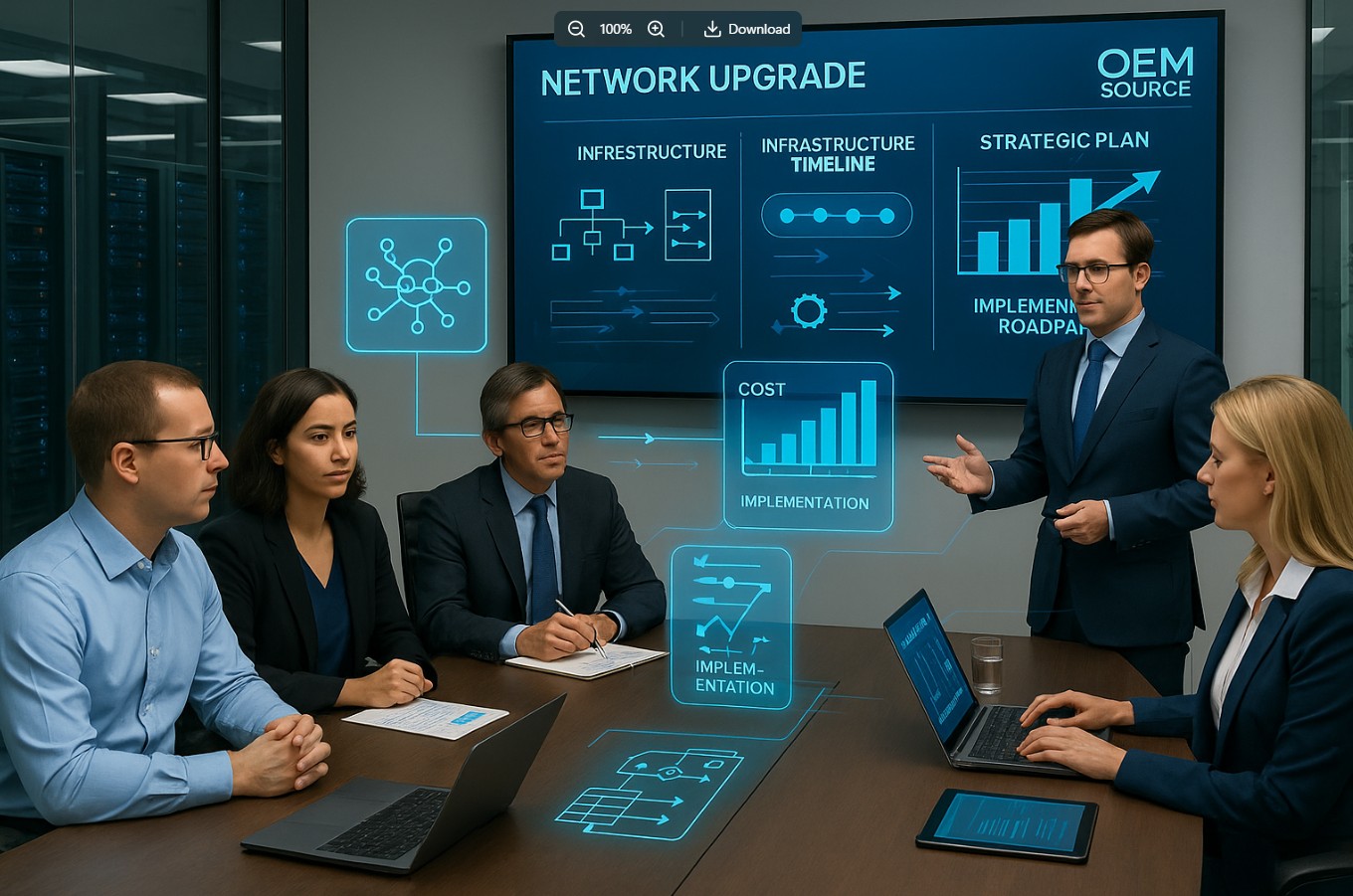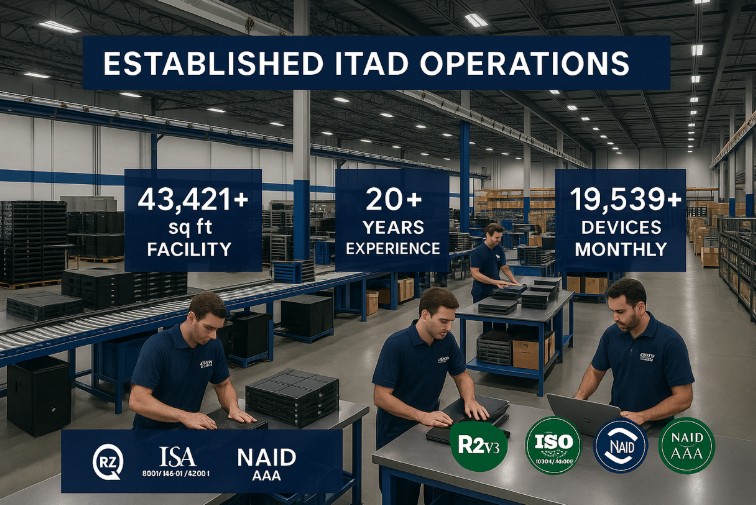Picture this: 80% of your workforce is trying to connect remotely through outdated VPN concentrators that buckle under pressure, while your competitors seamlessly support distributed teams with modern cloud connectivity solutions. This scenario isn’t hypothetical, it’s the reality facing countless organizations still clinging to legacy infrastructure that can no longer meet today’s business demands.
Across the United States and globally, carriers are phasing out copper lines at an accelerating pace, according to Gartner. This shift is forcing IT leaders to confront a critical truth: many network foundations are crumbling under the weight of digital transformation requirements. Companies that delay upgrades risk falling behind, unable to operate at the speed business now demands.
This guide outlines strategic approaches and proven methodologies that leading organizations use to modernize network infrastructure, turning outdated systems from liabilities into competitive advantages.
Understanding the Need for Network Revamp
Modern business operations demand network infrastructure capable of supporting unprecedented levels of connectivity, performance, and security. The shift toward remote work, cloud-first strategies, and emerging technologies like artificial intelligence and machine learning has fundamentally changed what network infrastructure must deliver to remain competitive.
Legacy equipment that once provided adequate performance now acts as a bottleneck to innovation. These aging systems lack the capacity, flexibility, and built-in security features required to support modern applications and user expectations.
Identifying Signs of Outdated Infrastructure
Infrastructure degradation often reveals itself through multiple indicators that organizations must recognize before performance issues escalate.
Common indicators include:
- Performance degradation – Slow response times, frequent disconnections, and lagging application performance that affect user productivity
- Security vulnerabilities – Unsupported devices lacking modern security features or critical patches
- Capacity limitations – Inability to handle bandwidth demands from video conferencing, cloud tools, and modern SaaS environments
- Technology obsolescence – Incompatibility with innovations like Wi-Fi 6, SD-WAN, and VR/AR platforms
- Vendor support issues – End-of-life hardware with limited access to maintenance and replacement parts
Assessing Current Network Performance Issues
A comprehensive infrastructure assessment involves evaluation across both technical metrics and business impact.
Key assessment areas include:
- Network monitoring metrics – Track latency, throughput, packet loss, and availability to identify performance trends
- User experience indicators – Analyze help desk tickets and user feedback to uncover consistent pain points
- Business impact analysis – Quantify how performance issues affect revenue, productivity, and customer experience
- Capacity utilization review – Pinpoint bandwidth constraints or overloaded segments
- Security vulnerability scans – Identify compliance gaps, unpatched systems, and potential breach points
Setting Clear Upgrade Goals
Successful upgrades begin with clearly defined goals that align with business priorities and offer measurable outcomes. These objectives must balance operational needs with long-term strategic requirements to ensure sustainable value delivery.
Strategic alignment ensures that infrastructure investments support broader organizational goals, such as digital transformation initiatives, growth plans, and competitive positioning.
Defining Desired Outcomes
Upgrades should be driven by outcomes that are specific, measurable, and aligned to business value.
- Performance targets – Define minimum acceptable benchmarks for speed, reliability, and reliability
- Business enablement – Identify the capabilities the upgrade will unlock, such as cloud connectivity, remote work support, or emerging technology adoption
- Cost optimization – Balance performance enhancements with long-term cost efficiency and total cost of ownership reduction
Prioritizing Essential Improvements
Not all upgrades deliver equal impact. Prioritization should be based on:
- Business impact assessment – Focus on upgrades that improve mission-critical functions
- Technical feasibility – Consider complexity, compatibility, and risk
- Resource requirements – Evaluate internal capacity and available budget
- Risk mitigation – Address the most vulnerable systems first
- Quick win identification – Seek early improvements that build momentum and stakeholder support
Planning the Upgrade Process
Effective infrastructure upgrade planning requires a comprehensive, phased approach that accounts for technical, operational, and business demands. The planning process must account for the complexity of network infrastructure while minimizing business disruption during implementation.
Project management frameworks provide the structure needed to manage timelines, budgets, and implementation milestones across large-scale infrastructure initiatives.
Creating a Step-by-Step Action Plan
Breaking upgrades into structured phases enables organizations to execute each stage methodically while minimizing operational disruptions. Phase-based rollouts also allow for early validation and course correction before full deployment.
Typical implementation phases include:
- Assessment and Design Phase – Evaluate current infrastructure and develop a future-state architecture aligned to business goals
- Procurement and Preparation Phase – Acquire hardware and software, coordinate vendors, and prepare internal teams
- Pilot Implementation Phase – Conduct a limited deployment to validate design and implementation approaches
- Production Rollout Phase – Scale the implementation across the organization with performance monitoring and user support
- Optimization and Stabilization Phase – Fine-tune configurations, resolve issues, and transfer to long-term operations and maintenance
Estimating Costs and Resources Needed
Accurate cost forecasting requires a comprehensive analysis of all project components, including equipment, services, internal resources, and indirect costs.
Industry research indicates installation labor accounts for approximately 60% of total project costs in infrastructure projects, highlighting the importance of thorough planning and resource allocation.
Equipment costs include hardware, software, and licensing requirements for the target infrastructure. Implementation costs encompass professional services, internal labor, and project management resources required to execute the upgrade successfully.
Engaging with Knowledgeable Partners
Collaborating with experienced vendors and consultants can significantly improve upgrade outcomes. These partnerships provide access to specialized expertise, proven methodologies, and implementation resources that may not be available internally.
Key benefits of expert partnerships include:
- Specialized knowledge access – Network architecture, cybersecurity, scalability, and vendor-specific knowledge
- Proven methodologies – Access to repeatable, field-tested processes that reduce error and improve execution speed
- Accelerated timelines – Leverage external resources to reduce implementation time
- Risk mitigation – Avoid common mistakes through expert planning and validation
- Vendor relationships – Gain access to preferred pricing, support SLAs, and product roadmaps
- Technical validation – Ensure upgrades adhere to industry best practices and compliance requirements
Selecting the Right Vendors and Consultants
Vendor selection should be a structured evaluation process that balances technical capability with alignment to your organization’s culture and goals.
Selection criteria to consider:
- Technical Capabilities – Can they deliver the specific solutions and long-term support needed?
- Industry Experience – Have they completed similar projects in comparable environments?
- Financial and Operational Stability – Are they positioned to provide reliable support over the equipment lifecycle?
- Support Quality – What post-implementation services are available (e.g., 24/7 support, on-site service, knowledge transfer)?
- Cultural Fit – Do their processes and communication styles align with your internal team’s working model?
Balancing Legacy Systems with Modern Solutions
Modernizing network infrastructure often requires integrating new technologies with existing legacy systems that cannot be replaced immediately. This challenge demands strategic approaches that preserve the value of past investments while enabling long-term scalability, performance, and innovation.
Successful modernization depends on balancing technical compatibility and operational continuity without disrupting core business functions.
Strategies for Integrating New and Old Technologies
Integration strategies must address the technical and operational challenges of connecting modern network components with older infrastructure. Phased migration enables organizations to upgrade infrastructure incrementally while maintaining operational continuity.
Effective integration techniques include:
- Bridge technologies – Solutions such as protocol converters or media gateways that allow modern systems to communicate with legacy devices
- Hybrid architecture models – Combining cloud-based and on-premises solutions to support gradual modernization
- Virtualization – Using software-defined networking and virtual appliances to extend the capabilities of legacy systems
- Incremental feature upgrades – Upgrading certain functions or components while deferring full system replacement
Avoiding Common Pitfalls in System Integration
Without careful planning, integration efforts often face predictable roadblocks. Avoid these common missteps:
- Compatibility Conflicts – Mismatched protocols, interfaces, or standards can create technical challenges
- Unestimated Data Migration Complexity – Migrating data across incompatible systems requires careful mapping and testing
- Security Model Misalignment – Integrating systems with access controls or encryption standards can create vulnerabilities
- Inadequate Testing – Failure to simulate real-world operating conditions can result in performance or availability issues post-deployment
Building a Strong Business Case
Network upgrades must be justified to demonstrate clear value and return on investment (ROI). An effective business case aligns infrastructure improvements with broader organizational goals such as growth, security, or digital transformation.
Business cases should include:
- Strategic Alignment – Demonstrate how the upgrade supports innovation, remote work, cloud adoption, or customer experience improvements
- Risk Mitigation – Highlight how modernization reduces exposure to security threats, unplanned downtime, or vendor end-of-life timelines
- Total Cost of Ownership (TCO) Improvement – Show how lifecycle cost reductions offset upfront investment
Demonstrating ROI and Cost-Benefit Analysis
Return on investment (ROI) analysis requires a comprehensive evaluation of project costs against quantifiable benefits over the infrastructure’s operational life. Use a cost-benefit framework that compares the long-term financial and operational gains to the projected costs of the upgrade.
ROI elements to highlight:
- Operational Cost Savings – Lower maintenance costs, energy efficiency improvements, and fewer service disruptions
- Productivity Gains – Improved network speed, reduced latency, and more reliable connectivity for end-users
- Revenue Enablement – Ability to launch new services, scale to meet demand, or support advanced technologies (e.g., IoT, AI-driven analytics)
- Compliance and Security Cost Avoidance – Avoiding fines or remediation costs from outdated, non-compliant systems
Gaining Stakeholder Support and Approval
Stakeholder engagement requires targeted communication strategies that address specific audience concerns:
- Executive Communication – Emphasize strategic alignment, competitive positioning, and risk mitigation benefits of infrastructure modernization
- Operational Stakeholder Engagement – Address implementation impact, training requirements, and ongoing support considerations
- Financial Stakeholder Communication – Focus on cost justification, budget requirements, and financial risk management
- Technical Team Alignment – Ensure technical staff understand the implementation strategy and their specific responsibilities
- End-User Communication – Manage expectations about changes, benefits, and potential temporary disruptions
Prioritizing IT Infrastructure Improvements
Strategic prioritization ensures that infrastructure improvements deliver maximum value while managing resource constraints and implementation complexity. This process requires systematic evaluation of potential improvements against business impact and implementation feasibility.
Priority frameworks help organizations make informed decisions about which improvements to address first and how to sequence implementation for optimal results.
Identifying High-Impact Areas for Early Upgrades
Identifying high-impact areas involves analyzing infrastructure bottlenecks and their business implications. Areas that typically offer the greatest improvement potential include:
- Core Network Infrastructure – Upgrades here provide substantial performance gains since they affect all network traffic
- Security Infrastructure – Enhancements that address vulnerabilities or compliance mandates
- User-Facing Infrastructure – Improvements that directly impact employee productivity and user experience
- Cloud Connectivity – Upgrades that support remote work, SaaS integration, and other digital transformation initiatives
Addressing Security and Compliance Concerns
Security and compliance often drive infrastructure upgrade priorities due to regulatory requirements and risk management goals. Some compliance frameworks may require specific security capabilities or infrastructure standards that directly influence upgrade planning.
Security architecture integration ensures all new infrastructure components align with the broader security strategy and deliver consistent protection across the environment. Risk assessment and mitigation planning help identify and address potential vulnerabilities introduced by infrastructure changes.
Coordinating Between Network and Operations Teams
Successful infrastructure upgrades depend on close coordination between network engineering teams and IT operational teams. This alignment helps ensure that technical improvements align with operational requirements and support capabilities.
Cross-functional collaboration allows for early identification of implementation challenges and ensures all teams are aligned on responsibilities, handoffs, and escalation paths.
Ensuring Seamless Communication and Collaboration
Establishing clear communication channels and documentation standards is critical for coordination across stakeholders. Effective frameworks include:
- Regular Coordination Meetings – Promote transparency, progress updates, and issue resolution across teams
- Documentation Standards – Ensure technical details, configurations, and project decisions are clearly recorded and accessible
- Defined Communication Protocols – Clarify escalation paths and roles during planning and deployment
- Knowledge Transfer Processes – Ensure operational teams are prepared to support upgraded infrastructure long-term, including documentation and hands-on training
Assigning Roles and Responsibilities
A clear role definition prevents confusion and ensures that all essential tasks receive proper attention and resources. Common role assignments include:
- Project Management
- Technical Implementation
- Operational Support
- Change Management
- Quality Assurance
Managing New Technologies Post-Upgrade
Post-upgrade management is critical to ensuring infrastructure investments deliver ongoing value through proper operation, maintenance, and optimization. This phase requires continued focus on performance monitoring, staff enablement, and continuous improvement strategies.
Effective post-upgrade management transforms upgraded infrastructure from a completed project into a long-term strategic asset.
Training Staff on New Systems and Tools
Comprehensive training ensures that operational staff can manage the new infrastructure confidently and competently:
- Technical Training – Cover system operation, configuration management, and basic troubleshooting procedures
- Advanced Training – Focuses on performance optimization and complex troubleshooting for technical leads
- Ongoing Education Programs – Keep staff updated with technology developments and best practices
- Hands-On Practice Sessions – Offer guided experience with new tools in controlled environments
- Certification Programs – Support long-term professional development and validate technical competencies
Establishing Ongoing Support and Maintenance Plans
Maintenance planning ensures long-term infrastructure performance and reliability:
- Preventive Maintenance Schedules – Include routine system updates, performance monitoring, and proactive component replacement.
- Support Escalation Procedures – Define how issues are identified, prioritized, and resolved
- Performance Monitoring Processes – Track key performance indicators to ensure alignment with evolving business needs
- Vendor Support Coordination – Manage contracts and relationships to ensure reliable service delivery
- Documentation Maintenance – Keep all technical documentation updated and easily accessible for operational teams
Modernization Is a Strategic Advantage
When organizations need to dispose of legacy equipment during upgrades, Corporate IT Asset Disposition services provide secure, compliant solutions for equipment removal and data destruction. For large-scale infrastructure modernization projects, Data Center Disposition services offer comprehensive support for decommissioning and upgrading data center infrastructure while maximizing asset recovery and ensuring environmental compliance.
OEM Source provides the lifecycle expertise and trusted disposition services needed to modernize your network securely and strategically. From secure decommissioning to reliable replacement sourcing, we help IT leaders unlock performance, value, and compliance every step of the way.
Frequently Asked Questions
How do you upgrade IT infrastructure?
Upgrading IT infrastructure requires structured planning that includes performance assessment, future-state design, phased implementation, and stakeholder coordination. Begin with a comprehensive evaluation of existing infrastructure performance and business requirements. Then develop a detailed plan that minimizes disruption while delivering measurable improvements in performance, security, and scalability.
What are the three components of a network infrastructure?
The three core components of network infrastructure are hardware (routers, switches, cables, and access points), software (operating systems, network management tools, and security applications), and services (internet connectivity, cloud services, and support services).
These components work together to provide connectivity, security, and performance for organizational communications.
How do you upgrade network devices effectively?
Network device upgrades should follow a systematic approach, including inventory assessment, compatibility verification, backup procedures, staged implementation, and thorough testing.
Plan upgrades during maintenance windows, maintain configuration backups, and implement changes incrementally to minimize risk.
What’s the best way to reduce network connectivity issues during a major infrastructure upgrade?
To minimize connectivity issues, implement a phased rollout with parallel systems where possible. Conduct comprehensive testing in advance, maintain redundancy, and prepare rollback procedures. Schedule changes during off-peak hours and ensure support teams are prepared to resolve issues quickly.
How do you determine when network infrastructure needs upgrading?
Common signals include frequent downtime, slow performance, security vulnerabilities, and lack of compatibility with modern applications. Regular performance reviews, vendor support status checks, and business growth forecasts can help identify when upgrades are necessary to maintain reliability and compliance.





